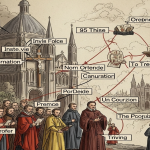DAVID, PAUL, DISMAS: A while ago, I blogged this excellent piece from the most recent First Things. It’s called “The Virtue of Hate,” and it argues that unlike Christians, Jews have no obligation to forgive those who perpetrate the most heinous crimes against them, and are fully justified in praying for their enemies’ eternal destruction–in Cynthia Ozick’s words, “Sooner a fly to God than he.”
The essay evoked sharp reactions from many Jews. Judith Weiss of Kesher Talk hooked me up with these two articles: a roundup article listing (but not detailing, unfortunately) rebuttals to Rabbi Soloveichik’s piece, and this book review discussing Jewish views of forgiveness. Although I much respect David Novak (one of the rebutters), I do think “The Virtue of Hate” had real insight, although Rabbi Soloveichik pushes the evidence farther than it can bear. There is a real difference in the Christian worldview, a real innovation that comes in with “as we forgive those who trespassed against us” and “lead all souls to Heaven, especially those in most need of Thy mercy.” “The Virtue of Hate” tried to sketch the boundaries of that innovation.
The worldview that Rabbi Soloveichik identifies as Jewish is an increasingly public one, and at last its claims are being taken seriously again. The “Virtue of Hate” worldview should have obvious appeal today, as we deal with people who are willing to use their own suicides to murder others. These are people who reject God in the name of God; who reject love and embrace prideful hatred with their last breaths. The sense of righteousness that drives much pro-war agitation has its best, truest basis in the worldview that Rabbi Soloveichik delineates–and if Christians or Jews cannot see the truths inherent in that worldview, I’m sorry, they need to check themselves, because to me, the virtue of hate is pretty obvious when the person hated has forfeited what we might think of as his “right” to forgiveness.
And yet I side with the Christians in Soloveichik’s essay, and with the Jews who reject his stance. I think there are a lot of reasons for that, but there are two that I’d like to talk about: my understanding of covenant, and the narrative I tell myself about my own life.
First, Covenant. I think this question can be most easily drawn out by asking if Rabbi Soloveichik would say, “Sooner a fly to God than he,” about a Jew who had committed acts of great evil? A Jewish Nazi (they did exist, bizarrely enough); a Jewish abortionist; a Jewish slaver; a Jewish Stalinist? I strongly suspect that the answer would be a troubled, reluctant “no–I would not.” He would acknowledge, as he quotes in his article, “Jeroboam has no portion in the World to Come”–but could he ever actually pray for that, or hope for it? Someone within the Covenant can never entirely escape the Covenant (hence so much of Philip Roth’s writing…); Jews, in my experience, sustain a sense of unyielding corporate responsibility toward all other Jews, by virtue of the Covenant and the Jews’ common mission to be a light unto the nations. For Christians that inescapable responsibility extends to all people, by virtue of our membership in the Body of Christ, which is given as a sacrifice for the whole world. We may acknowledge that some people will have no portion in the world to come, due to their own rejection of love, of God; but we couldn’t and shouldn’t pray for that.
And the Jewish figures of repentance are different from the Christian figures, also, in a way that deeply shapes the corresponding mindsets. The preeminent Jewish penitent is probably King David–the greatest of Judaism’s countless prodigal sons. David is a man within the Covenant who commits great sin–murder in order to facilitate adultery–and then, realizing his crime, repents and returns to God. He is always within the Covenant even when he rejects its strictures.
Contrast this to two key figures for Christians: St. Paul and the thief who accepts Christ on his cross. (Tradition has named the good thief Dismas.) St. Paul is not only a persecutor of the followers of the New Covenant, but an outsider to that covenant. He comes to Christ for the first time with hands bloodied, having persecuted the Body of Christ which he only now realizes holds the truth. Dismas is one of the many Christian examples of the deathbed conversion. Between the two of them, these New Testament figures foster our hope that anyone can be redeemed, at any moment, and their repentance and redemption may be known only to God. (How many people heard the thief’s confession? What if only Jesus had heard?)
I think that Christians are more likely to view themselves as Pauls, saved despite their outsider status, their lack of desert, their train of cruel and worthless deeds, than as Davids returning to the familiar fold. This is of course most true of converts; but Christianity’s strong emphasis on conversion shapes the mindset even of “cradle Christians.” And so Christians are more disposed to view all great sinners as potentially “not yet Christian”; we proclaim the old graveyard saw, the skeleton croaking, “What you were, so once was I; What I am, you too shall be,” though for us it is the not-yet-Christians who are the skeletons and we who have at least a chance at life. We are more willing to see even the worst crimes as precursors to repentance and salvation. (And this can lead, at times, to a cruel and false minimizing of real horror–“I am as bad as Hitler, thus Hitler is only as bad as me.” I think it is both possible and necessary to have a strong consciousness of one’s own Fallenness and one’s own evil deeds without minimizing the evil committed by others.)
I note again that these are only tendencies of thought or mindset, not necessary conclusions of theology. But I think they are real tendencies with real consequences. (If I were cooler, I would be able to sketch the ways in which these tendencies and concepts are related to differing Jewish and Christian understandings of justice vs. mercy, and of exile. But I’m not so I won’t.)











